Comprehensive HRM Report: HSBC's Strategies for Employee Management
VerifiedAdded on 2023/06/13
|16
|3272
|165
Report
AI Summary
This report provides a comprehensive analysis of Human Resource Management (HRM) practices at HSBC, a multinational financial institution. It covers key aspects such as workforce planning, strategic HRM, recruitment and selection approaches, and their respective strengths and weaknesses. The report also delves into the benefits and limitations of learning, development, and training programs, as well as performance management systems. Furthermore, it examines the relevance of HRM to organizational efficiency, effectiveness, and profitability, highlighting the importance of employee relations in influencing HRM decision-making. The impact of employment legislation, including The Equality Act 2010 and the Health and Safety at Work etc. Act 1974, on HRM decisions is also discussed. The report includes sample documents such as a job advertisement, job description, person specification, interview questionnaire, and appointment letter, providing practical insights into HRM implementation at HSBC. This document is available on Desklib, a platform offering study tools and resources for students.
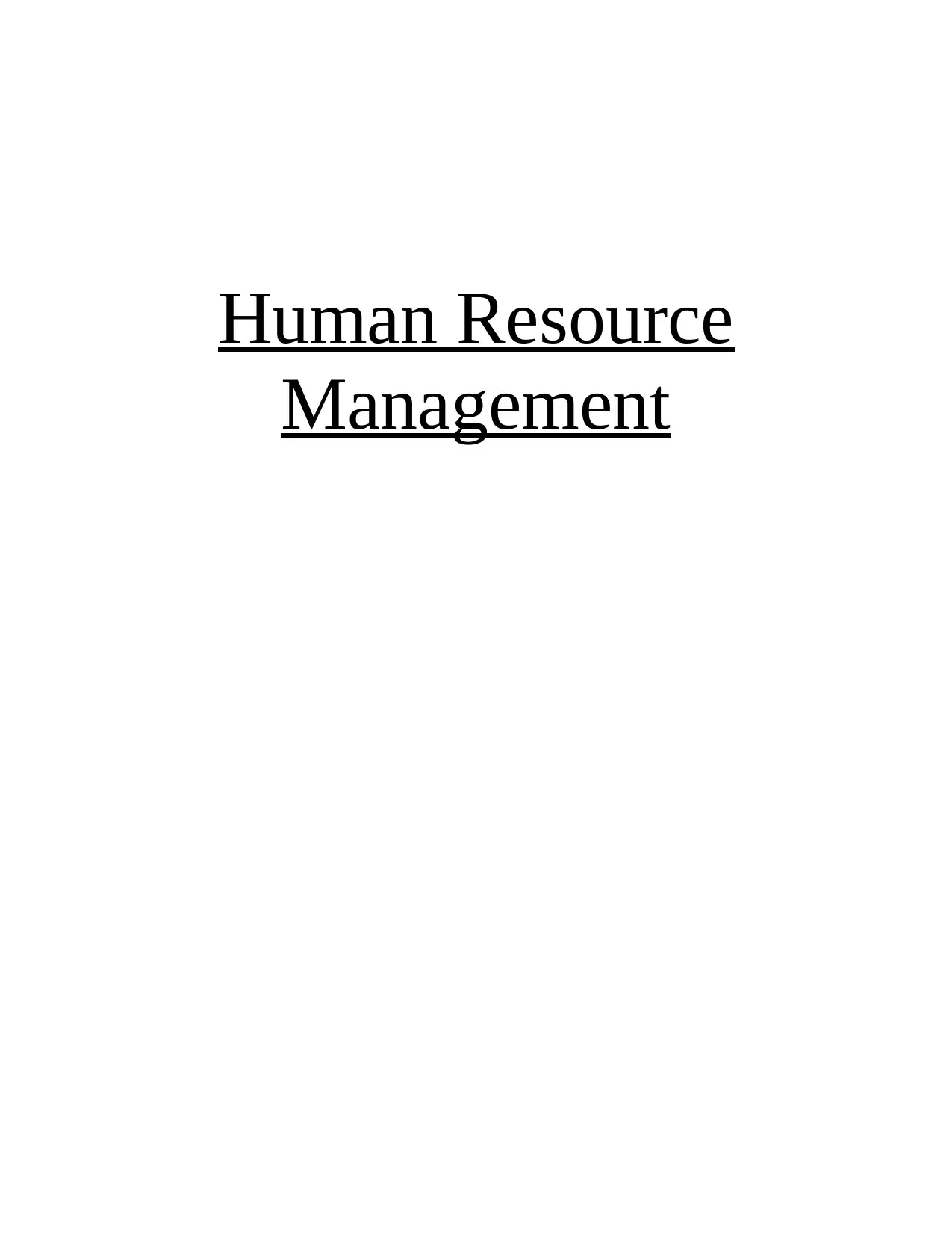
Human Resource
Management
Management
Paraphrase This Document
Need a fresh take? Get an instant paraphrase of this document with our AI Paraphraser
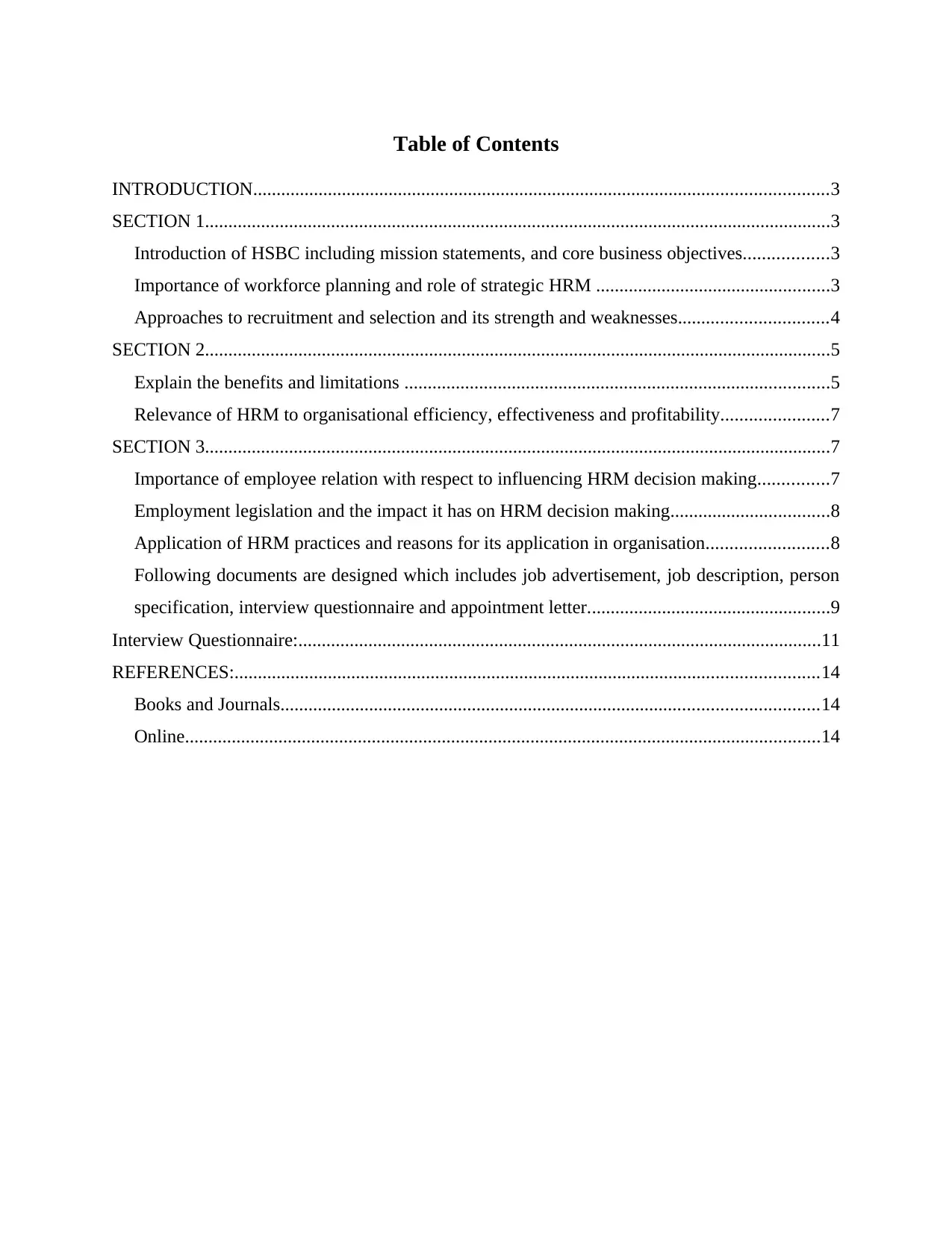
Table of Contents
INTRODUCTION...........................................................................................................................3
SECTION 1......................................................................................................................................3
Introduction of HSBC including mission statements, and core business objectives..................3
Importance of workforce planning and role of strategic HRM ..................................................3
Approaches to recruitment and selection and its strength and weaknesses................................4
SECTION 2......................................................................................................................................5
Explain the benefits and limitations ...........................................................................................5
Relevance of HRM to organisational efficiency, effectiveness and profitability.......................7
SECTION 3......................................................................................................................................7
Importance of employee relation with respect to influencing HRM decision making...............7
Employment legislation and the impact it has on HRM decision making..................................8
Application of HRM practices and reasons for its application in organisation..........................8
Following documents are designed which includes job advertisement, job description, person
specification, interview questionnaire and appointment letter....................................................9
Interview Questionnaire:................................................................................................................11
REFERENCES:.............................................................................................................................14
Books and Journals...................................................................................................................14
Online........................................................................................................................................14
INTRODUCTION...........................................................................................................................3
SECTION 1......................................................................................................................................3
Introduction of HSBC including mission statements, and core business objectives..................3
Importance of workforce planning and role of strategic HRM ..................................................3
Approaches to recruitment and selection and its strength and weaknesses................................4
SECTION 2......................................................................................................................................5
Explain the benefits and limitations ...........................................................................................5
Relevance of HRM to organisational efficiency, effectiveness and profitability.......................7
SECTION 3......................................................................................................................................7
Importance of employee relation with respect to influencing HRM decision making...............7
Employment legislation and the impact it has on HRM decision making..................................8
Application of HRM practices and reasons for its application in organisation..........................8
Following documents are designed which includes job advertisement, job description, person
specification, interview questionnaire and appointment letter....................................................9
Interview Questionnaire:................................................................................................................11
REFERENCES:.............................................................................................................................14
Books and Journals...................................................................................................................14
Online........................................................................................................................................14
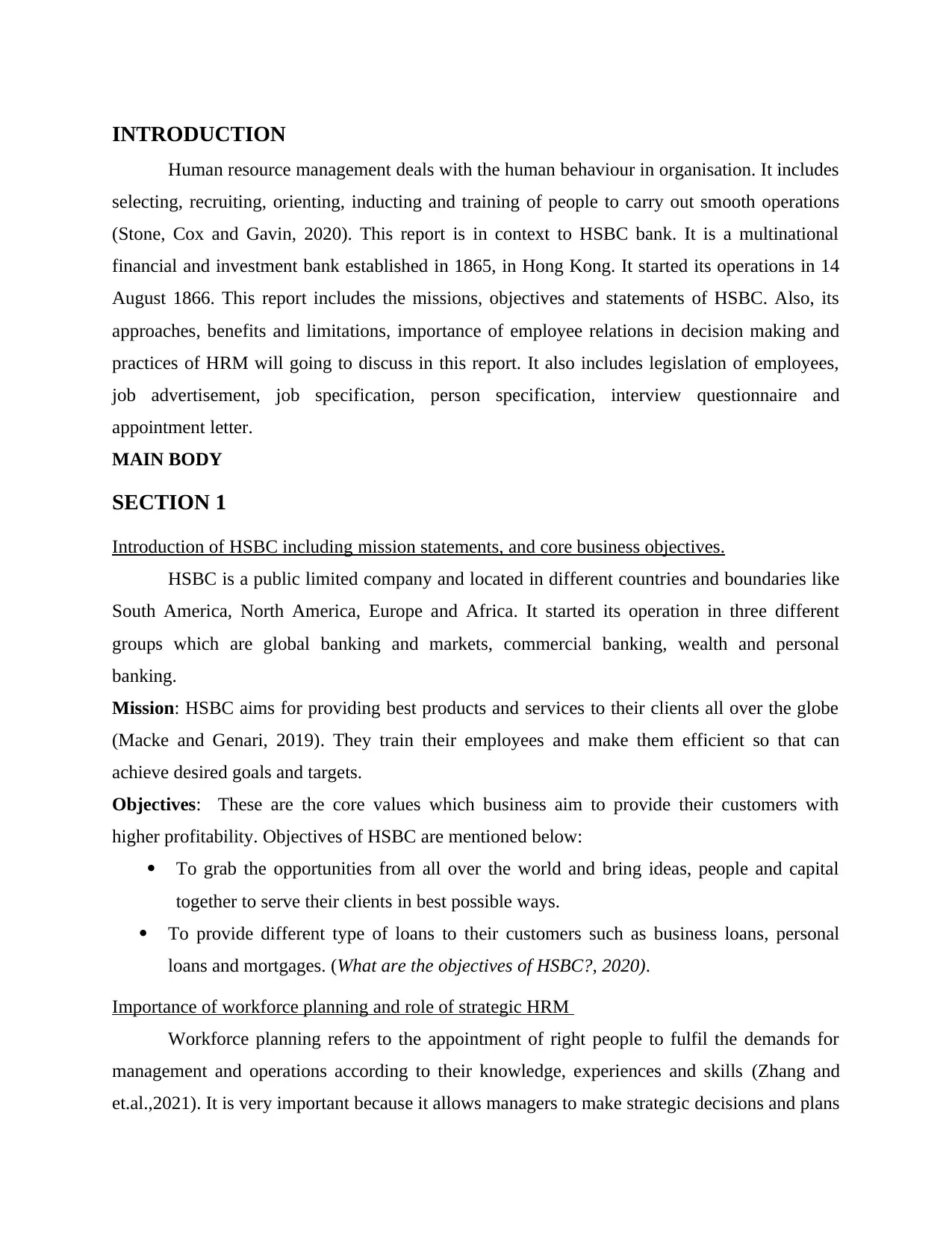
INTRODUCTION
Human resource management deals with the human behaviour in organisation. It includes
selecting, recruiting, orienting, inducting and training of people to carry out smooth operations
(Stone, Cox and Gavin, 2020). This report is in context to HSBC bank. It is a multinational
financial and investment bank established in 1865, in Hong Kong. It started its operations in 14
August 1866. This report includes the missions, objectives and statements of HSBC. Also, its
approaches, benefits and limitations, importance of employee relations in decision making and
practices of HRM will going to discuss in this report. It also includes legislation of employees,
job advertisement, job specification, person specification, interview questionnaire and
appointment letter.
MAIN BODY
SECTION 1
Introduction of HSBC including mission statements, and core business objectives.
HSBC is a public limited company and located in different countries and boundaries like
South America, North America, Europe and Africa. It started its operation in three different
groups which are global banking and markets, commercial banking, wealth and personal
banking.
Mission: HSBC aims for providing best products and services to their clients all over the globe
(Macke and Genari, 2019). They train their employees and make them efficient so that can
achieve desired goals and targets.
Objectives: These are the core values which business aim to provide their customers with
higher profitability. Objectives of HSBC are mentioned below:
To grab the opportunities from all over the world and bring ideas, people and capital
together to serve their clients in best possible ways.
To provide different type of loans to their customers such as business loans, personal
loans and mortgages. (What are the objectives of HSBC?, 2020).
Importance of workforce planning and role of strategic HRM
Workforce planning refers to the appointment of right people to fulfil the demands for
management and operations according to their knowledge, experiences and skills (Zhang and
et.al.,2021). It is very important because it allows managers to make strategic decisions and plans
Human resource management deals with the human behaviour in organisation. It includes
selecting, recruiting, orienting, inducting and training of people to carry out smooth operations
(Stone, Cox and Gavin, 2020). This report is in context to HSBC bank. It is a multinational
financial and investment bank established in 1865, in Hong Kong. It started its operations in 14
August 1866. This report includes the missions, objectives and statements of HSBC. Also, its
approaches, benefits and limitations, importance of employee relations in decision making and
practices of HRM will going to discuss in this report. It also includes legislation of employees,
job advertisement, job specification, person specification, interview questionnaire and
appointment letter.
MAIN BODY
SECTION 1
Introduction of HSBC including mission statements, and core business objectives.
HSBC is a public limited company and located in different countries and boundaries like
South America, North America, Europe and Africa. It started its operation in three different
groups which are global banking and markets, commercial banking, wealth and personal
banking.
Mission: HSBC aims for providing best products and services to their clients all over the globe
(Macke and Genari, 2019). They train their employees and make them efficient so that can
achieve desired goals and targets.
Objectives: These are the core values which business aim to provide their customers with
higher profitability. Objectives of HSBC are mentioned below:
To grab the opportunities from all over the world and bring ideas, people and capital
together to serve their clients in best possible ways.
To provide different type of loans to their customers such as business loans, personal
loans and mortgages. (What are the objectives of HSBC?, 2020).
Importance of workforce planning and role of strategic HRM
Workforce planning refers to the appointment of right people to fulfil the demands for
management and operations according to their knowledge, experiences and skills (Zhang and
et.al.,2021). It is very important because it allows managers to make strategic decisions and plans
⊘ This is a preview!⊘
Do you want full access?
Subscribe today to unlock all pages.

Trusted by 1+ million students worldwide
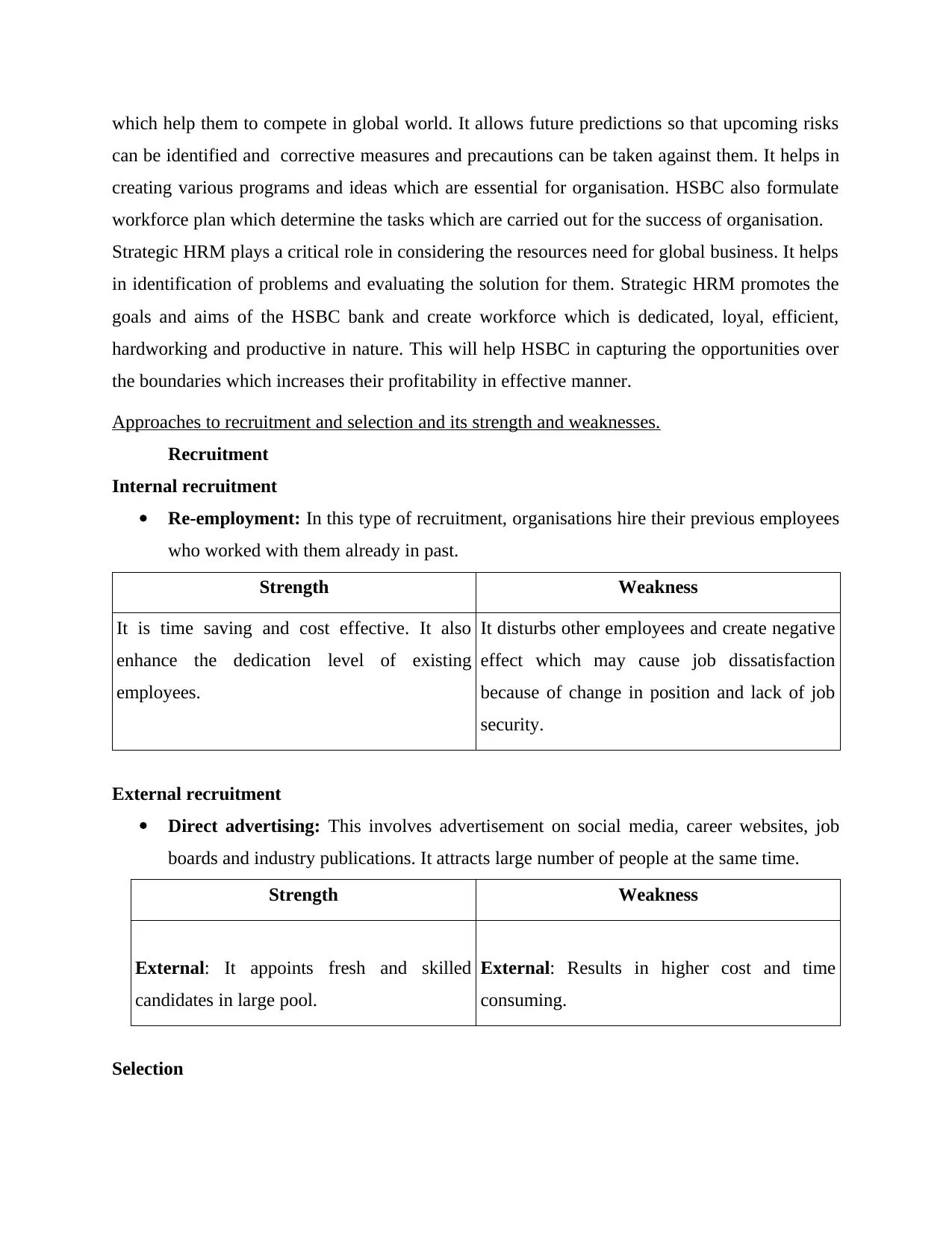
which help them to compete in global world. It allows future predictions so that upcoming risks
can be identified and corrective measures and precautions can be taken against them. It helps in
creating various programs and ideas which are essential for organisation. HSBC also formulate
workforce plan which determine the tasks which are carried out for the success of organisation.
Strategic HRM plays a critical role in considering the resources need for global business. It helps
in identification of problems and evaluating the solution for them. Strategic HRM promotes the
goals and aims of the HSBC bank and create workforce which is dedicated, loyal, efficient,
hardworking and productive in nature. This will help HSBC in capturing the opportunities over
the boundaries which increases their profitability in effective manner.
Approaches to recruitment and selection and its strength and weaknesses.
Recruitment
Internal recruitment
Re-employment: In this type of recruitment, organisations hire their previous employees
who worked with them already in past.
Strength Weakness
It is time saving and cost effective. It also
enhance the dedication level of existing
employees.
It disturbs other employees and create negative
effect which may cause job dissatisfaction
because of change in position and lack of job
security.
External recruitment
Direct advertising: This involves advertisement on social media, career websites, job
boards and industry publications. It attracts large number of people at the same time.
Strength Weakness
External: It appoints fresh and skilled
candidates in large pool.
External: Results in higher cost and time
consuming.
Selection
can be identified and corrective measures and precautions can be taken against them. It helps in
creating various programs and ideas which are essential for organisation. HSBC also formulate
workforce plan which determine the tasks which are carried out for the success of organisation.
Strategic HRM plays a critical role in considering the resources need for global business. It helps
in identification of problems and evaluating the solution for them. Strategic HRM promotes the
goals and aims of the HSBC bank and create workforce which is dedicated, loyal, efficient,
hardworking and productive in nature. This will help HSBC in capturing the opportunities over
the boundaries which increases their profitability in effective manner.
Approaches to recruitment and selection and its strength and weaknesses.
Recruitment
Internal recruitment
Re-employment: In this type of recruitment, organisations hire their previous employees
who worked with them already in past.
Strength Weakness
It is time saving and cost effective. It also
enhance the dedication level of existing
employees.
It disturbs other employees and create negative
effect which may cause job dissatisfaction
because of change in position and lack of job
security.
External recruitment
Direct advertising: This involves advertisement on social media, career websites, job
boards and industry publications. It attracts large number of people at the same time.
Strength Weakness
External: It appoints fresh and skilled
candidates in large pool.
External: Results in higher cost and time
consuming.
Selection
Paraphrase This Document
Need a fresh take? Get an instant paraphrase of this document with our AI Paraphraser
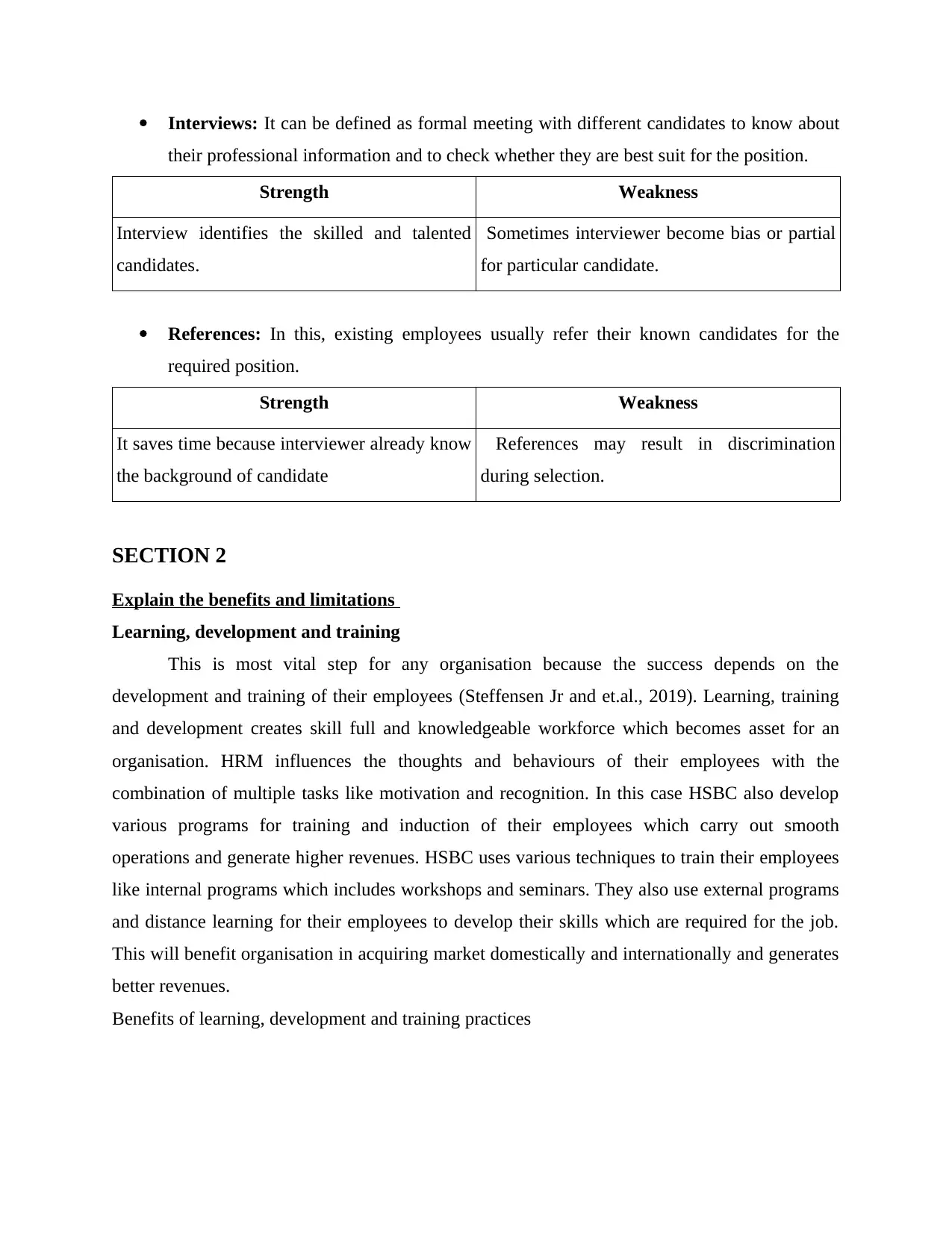
Interviews: It can be defined as formal meeting with different candidates to know about
their professional information and to check whether they are best suit for the position.
Strength Weakness
Interview identifies the skilled and talented
candidates.
Sometimes interviewer become bias or partial
for particular candidate.
References: In this, existing employees usually refer their known candidates for the
required position.
Strength Weakness
It saves time because interviewer already know
the background of candidate
References may result in discrimination
during selection.
SECTION 2
Explain the benefits and limitations
Learning, development and training
This is most vital step for any organisation because the success depends on the
development and training of their employees (Steffensen Jr and et.al., 2019). Learning, training
and development creates skill full and knowledgeable workforce which becomes asset for an
organisation. HRM influences the thoughts and behaviours of their employees with the
combination of multiple tasks like motivation and recognition. In this case HSBC also develop
various programs for training and induction of their employees which carry out smooth
operations and generate higher revenues. HSBC uses various techniques to train their employees
like internal programs which includes workshops and seminars. They also use external programs
and distance learning for their employees to develop their skills which are required for the job.
This will benefit organisation in acquiring market domestically and internationally and generates
better revenues.
Benefits of learning, development and training practices
their professional information and to check whether they are best suit for the position.
Strength Weakness
Interview identifies the skilled and talented
candidates.
Sometimes interviewer become bias or partial
for particular candidate.
References: In this, existing employees usually refer their known candidates for the
required position.
Strength Weakness
It saves time because interviewer already know
the background of candidate
References may result in discrimination
during selection.
SECTION 2
Explain the benefits and limitations
Learning, development and training
This is most vital step for any organisation because the success depends on the
development and training of their employees (Steffensen Jr and et.al., 2019). Learning, training
and development creates skill full and knowledgeable workforce which becomes asset for an
organisation. HRM influences the thoughts and behaviours of their employees with the
combination of multiple tasks like motivation and recognition. In this case HSBC also develop
various programs for training and induction of their employees which carry out smooth
operations and generate higher revenues. HSBC uses various techniques to train their employees
like internal programs which includes workshops and seminars. They also use external programs
and distance learning for their employees to develop their skills which are required for the job.
This will benefit organisation in acquiring market domestically and internationally and generates
better revenues.
Benefits of learning, development and training practices
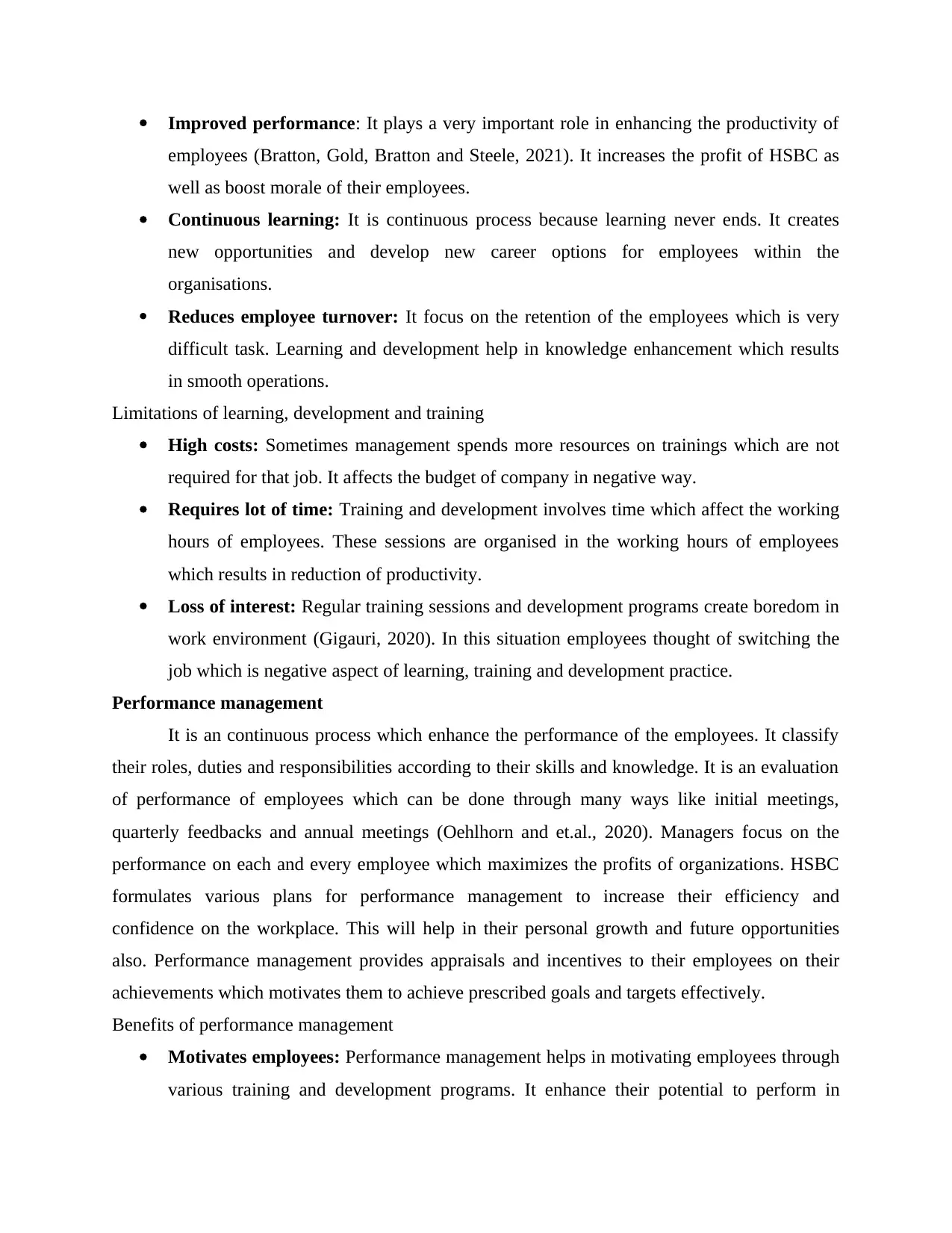
Improved performance: It plays a very important role in enhancing the productivity of
employees (Bratton, Gold, Bratton and Steele, 2021). It increases the profit of HSBC as
well as boost morale of their employees.
Continuous learning: It is continuous process because learning never ends. It creates
new opportunities and develop new career options for employees within the
organisations.
Reduces employee turnover: It focus on the retention of the employees which is very
difficult task. Learning and development help in knowledge enhancement which results
in smooth operations.
Limitations of learning, development and training
High costs: Sometimes management spends more resources on trainings which are not
required for that job. It affects the budget of company in negative way.
Requires lot of time: Training and development involves time which affect the working
hours of employees. These sessions are organised in the working hours of employees
which results in reduction of productivity.
Loss of interest: Regular training sessions and development programs create boredom in
work environment (Gigauri, 2020). In this situation employees thought of switching the
job which is negative aspect of learning, training and development practice.
Performance management
It is an continuous process which enhance the performance of the employees. It classify
their roles, duties and responsibilities according to their skills and knowledge. It is an evaluation
of performance of employees which can be done through many ways like initial meetings,
quarterly feedbacks and annual meetings (Oehlhorn and et.al., 2020). Managers focus on the
performance on each and every employee which maximizes the profits of organizations. HSBC
formulates various plans for performance management to increase their efficiency and
confidence on the workplace. This will help in their personal growth and future opportunities
also. Performance management provides appraisals and incentives to their employees on their
achievements which motivates them to achieve prescribed goals and targets effectively.
Benefits of performance management
Motivates employees: Performance management helps in motivating employees through
various training and development programs. It enhance their potential to perform in
employees (Bratton, Gold, Bratton and Steele, 2021). It increases the profit of HSBC as
well as boost morale of their employees.
Continuous learning: It is continuous process because learning never ends. It creates
new opportunities and develop new career options for employees within the
organisations.
Reduces employee turnover: It focus on the retention of the employees which is very
difficult task. Learning and development help in knowledge enhancement which results
in smooth operations.
Limitations of learning, development and training
High costs: Sometimes management spends more resources on trainings which are not
required for that job. It affects the budget of company in negative way.
Requires lot of time: Training and development involves time which affect the working
hours of employees. These sessions are organised in the working hours of employees
which results in reduction of productivity.
Loss of interest: Regular training sessions and development programs create boredom in
work environment (Gigauri, 2020). In this situation employees thought of switching the
job which is negative aspect of learning, training and development practice.
Performance management
It is an continuous process which enhance the performance of the employees. It classify
their roles, duties and responsibilities according to their skills and knowledge. It is an evaluation
of performance of employees which can be done through many ways like initial meetings,
quarterly feedbacks and annual meetings (Oehlhorn and et.al., 2020). Managers focus on the
performance on each and every employee which maximizes the profits of organizations. HSBC
formulates various plans for performance management to increase their efficiency and
confidence on the workplace. This will help in their personal growth and future opportunities
also. Performance management provides appraisals and incentives to their employees on their
achievements which motivates them to achieve prescribed goals and targets effectively.
Benefits of performance management
Motivates employees: Performance management helps in motivating employees through
various training and development programs. It enhance their potential to perform in
⊘ This is a preview!⊘
Do you want full access?
Subscribe today to unlock all pages.

Trusted by 1+ million students worldwide
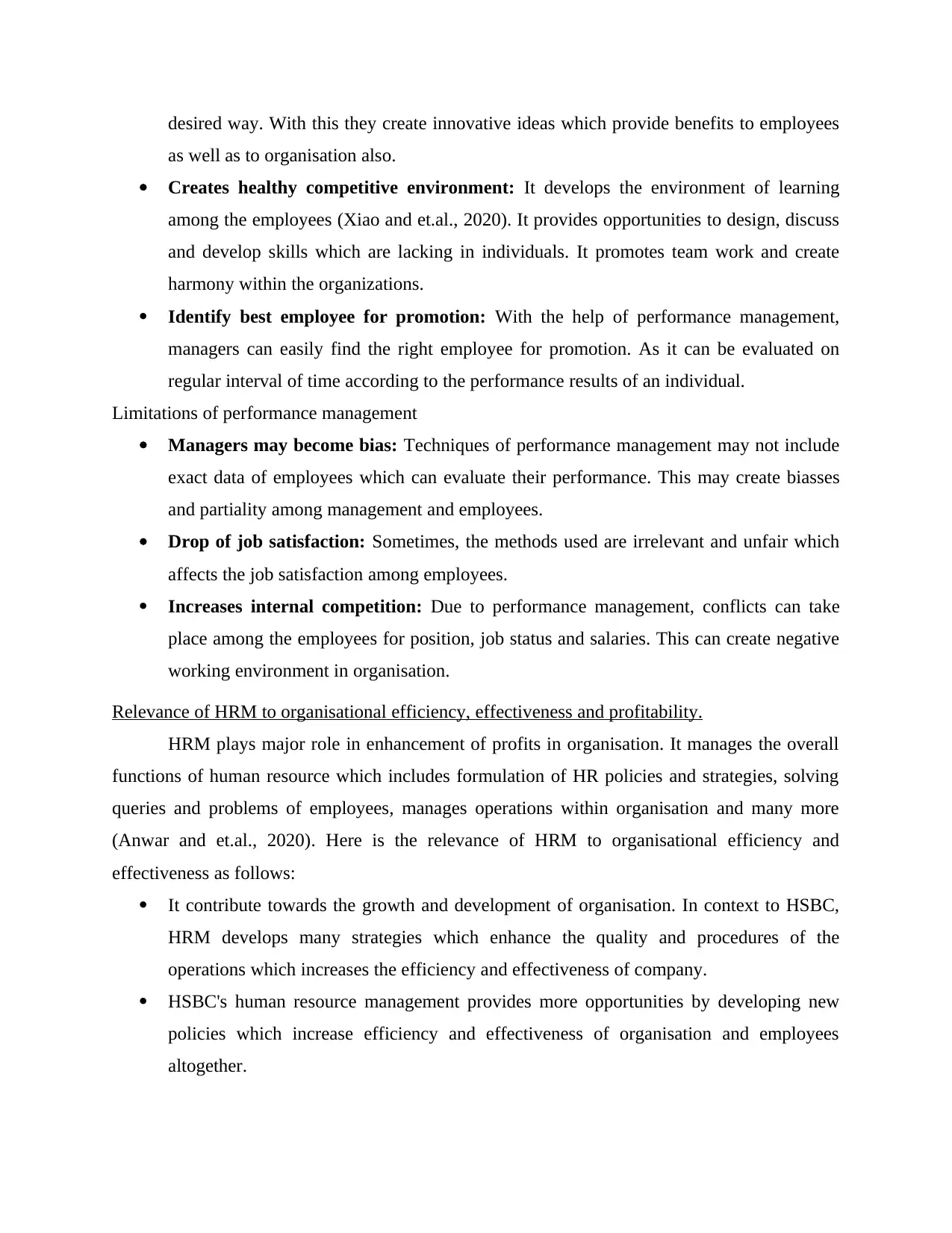
desired way. With this they create innovative ideas which provide benefits to employees
as well as to organisation also.
Creates healthy competitive environment: It develops the environment of learning
among the employees (Xiao and et.al., 2020). It provides opportunities to design, discuss
and develop skills which are lacking in individuals. It promotes team work and create
harmony within the organizations.
Identify best employee for promotion: With the help of performance management,
managers can easily find the right employee for promotion. As it can be evaluated on
regular interval of time according to the performance results of an individual.
Limitations of performance management
Managers may become bias: Techniques of performance management may not include
exact data of employees which can evaluate their performance. This may create biasses
and partiality among management and employees.
Drop of job satisfaction: Sometimes, the methods used are irrelevant and unfair which
affects the job satisfaction among employees.
Increases internal competition: Due to performance management, conflicts can take
place among the employees for position, job status and salaries. This can create negative
working environment in organisation.
Relevance of HRM to organisational efficiency, effectiveness and profitability.
HRM plays major role in enhancement of profits in organisation. It manages the overall
functions of human resource which includes formulation of HR policies and strategies, solving
queries and problems of employees, manages operations within organisation and many more
(Anwar and et.al., 2020). Here is the relevance of HRM to organisational efficiency and
effectiveness as follows:
It contribute towards the growth and development of organisation. In context to HSBC,
HRM develops many strategies which enhance the quality and procedures of the
operations which increases the efficiency and effectiveness of company.
HSBC's human resource management provides more opportunities by developing new
policies which increase efficiency and effectiveness of organisation and employees
altogether.
as well as to organisation also.
Creates healthy competitive environment: It develops the environment of learning
among the employees (Xiao and et.al., 2020). It provides opportunities to design, discuss
and develop skills which are lacking in individuals. It promotes team work and create
harmony within the organizations.
Identify best employee for promotion: With the help of performance management,
managers can easily find the right employee for promotion. As it can be evaluated on
regular interval of time according to the performance results of an individual.
Limitations of performance management
Managers may become bias: Techniques of performance management may not include
exact data of employees which can evaluate their performance. This may create biasses
and partiality among management and employees.
Drop of job satisfaction: Sometimes, the methods used are irrelevant and unfair which
affects the job satisfaction among employees.
Increases internal competition: Due to performance management, conflicts can take
place among the employees for position, job status and salaries. This can create negative
working environment in organisation.
Relevance of HRM to organisational efficiency, effectiveness and profitability.
HRM plays major role in enhancement of profits in organisation. It manages the overall
functions of human resource which includes formulation of HR policies and strategies, solving
queries and problems of employees, manages operations within organisation and many more
(Anwar and et.al., 2020). Here is the relevance of HRM to organisational efficiency and
effectiveness as follows:
It contribute towards the growth and development of organisation. In context to HSBC,
HRM develops many strategies which enhance the quality and procedures of the
operations which increases the efficiency and effectiveness of company.
HSBC's human resource management provides more opportunities by developing new
policies which increase efficiency and effectiveness of organisation and employees
altogether.
Paraphrase This Document
Need a fresh take? Get an instant paraphrase of this document with our AI Paraphraser
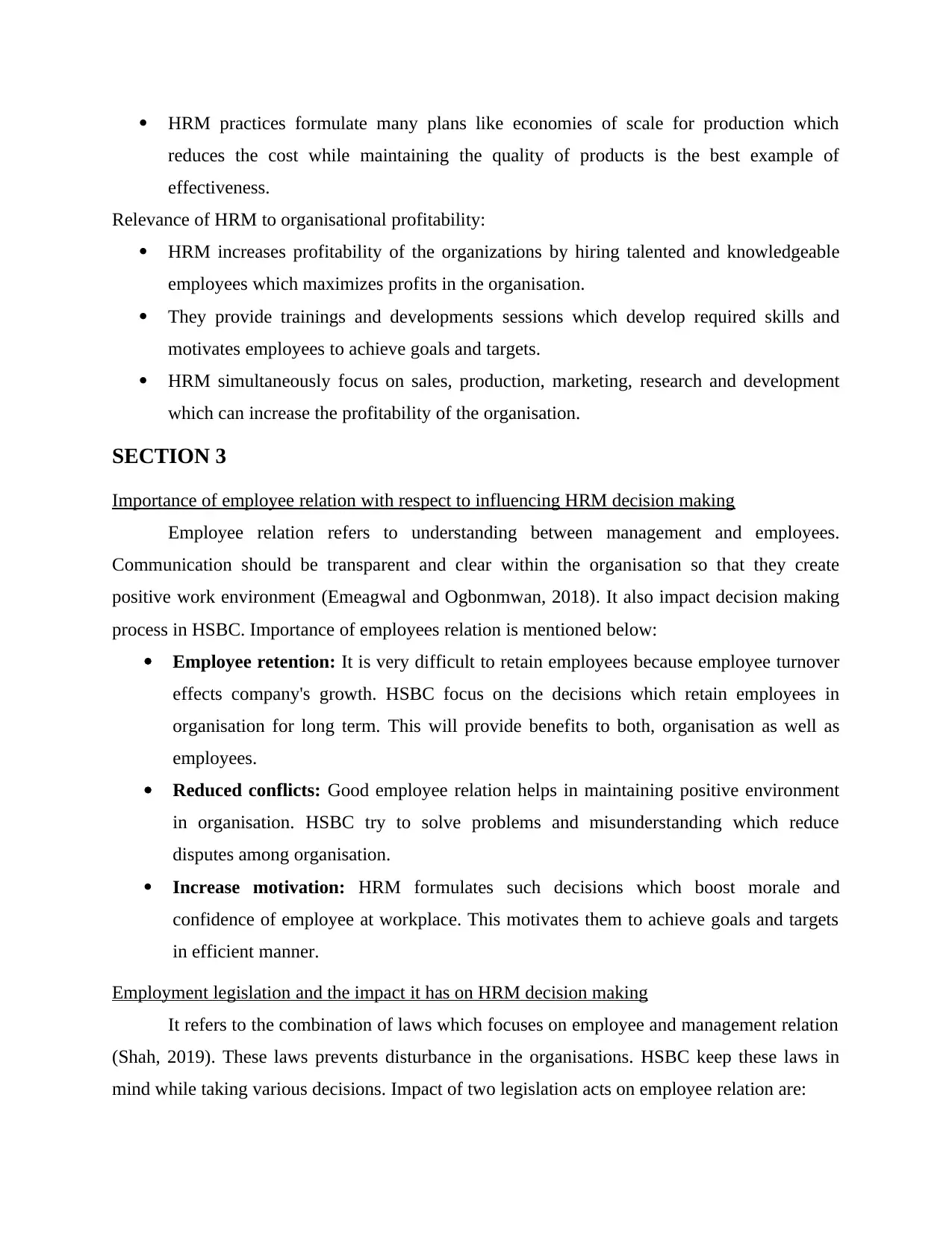
HRM practices formulate many plans like economies of scale for production which
reduces the cost while maintaining the quality of products is the best example of
effectiveness.
Relevance of HRM to organisational profitability:
HRM increases profitability of the organizations by hiring talented and knowledgeable
employees which maximizes profits in the organisation.
They provide trainings and developments sessions which develop required skills and
motivates employees to achieve goals and targets.
HRM simultaneously focus on sales, production, marketing, research and development
which can increase the profitability of the organisation.
SECTION 3
Importance of employee relation with respect to influencing HRM decision making
Employee relation refers to understanding between management and employees.
Communication should be transparent and clear within the organisation so that they create
positive work environment (Emeagwal and Ogbonmwan, 2018). It also impact decision making
process in HSBC. Importance of employees relation is mentioned below:
Employee retention: It is very difficult to retain employees because employee turnover
effects company's growth. HSBC focus on the decisions which retain employees in
organisation for long term. This will provide benefits to both, organisation as well as
employees.
Reduced conflicts: Good employee relation helps in maintaining positive environment
in organisation. HSBC try to solve problems and misunderstanding which reduce
disputes among organisation.
Increase motivation: HRM formulates such decisions which boost morale and
confidence of employee at workplace. This motivates them to achieve goals and targets
in efficient manner.
Employment legislation and the impact it has on HRM decision making
It refers to the combination of laws which focuses on employee and management relation
(Shah, 2019). These laws prevents disturbance in the organisations. HSBC keep these laws in
mind while taking various decisions. Impact of two legislation acts on employee relation are:
reduces the cost while maintaining the quality of products is the best example of
effectiveness.
Relevance of HRM to organisational profitability:
HRM increases profitability of the organizations by hiring talented and knowledgeable
employees which maximizes profits in the organisation.
They provide trainings and developments sessions which develop required skills and
motivates employees to achieve goals and targets.
HRM simultaneously focus on sales, production, marketing, research and development
which can increase the profitability of the organisation.
SECTION 3
Importance of employee relation with respect to influencing HRM decision making
Employee relation refers to understanding between management and employees.
Communication should be transparent and clear within the organisation so that they create
positive work environment (Emeagwal and Ogbonmwan, 2018). It also impact decision making
process in HSBC. Importance of employees relation is mentioned below:
Employee retention: It is very difficult to retain employees because employee turnover
effects company's growth. HSBC focus on the decisions which retain employees in
organisation for long term. This will provide benefits to both, organisation as well as
employees.
Reduced conflicts: Good employee relation helps in maintaining positive environment
in organisation. HSBC try to solve problems and misunderstanding which reduce
disputes among organisation.
Increase motivation: HRM formulates such decisions which boost morale and
confidence of employee at workplace. This motivates them to achieve goals and targets
in efficient manner.
Employment legislation and the impact it has on HRM decision making
It refers to the combination of laws which focuses on employee and management relation
(Shah, 2019). These laws prevents disturbance in the organisations. HSBC keep these laws in
mind while taking various decisions. Impact of two legislation acts on employee relation are:
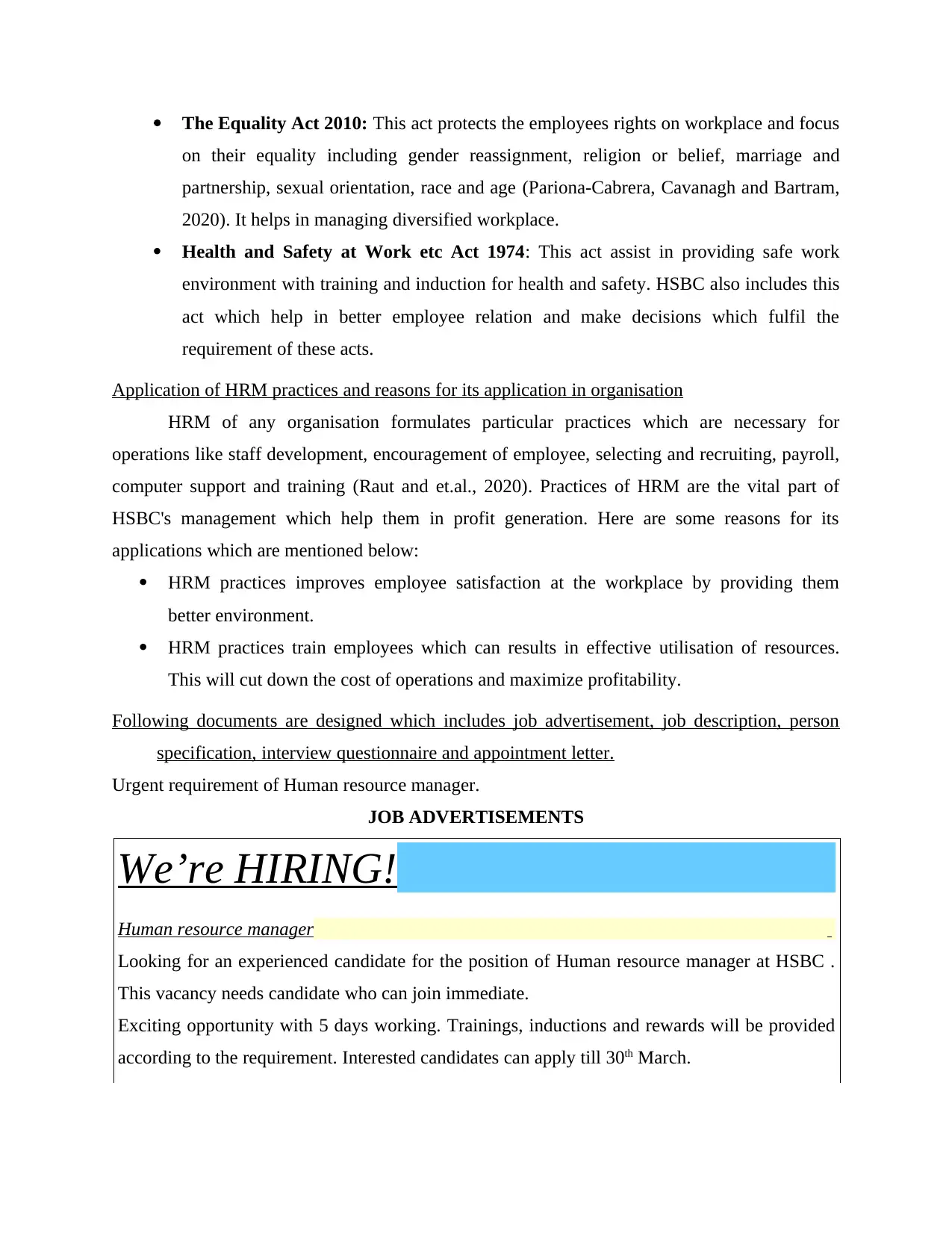
The Equality Act 2010: This act protects the employees rights on workplace and focus
on their equality including gender reassignment, religion or belief, marriage and
partnership, sexual orientation, race and age (Pariona‐Cabrera, Cavanagh and Bartram,
2020). It helps in managing diversified workplace.
Health and Safety at Work etc Act 1974: This act assist in providing safe work
environment with training and induction for health and safety. HSBC also includes this
act which help in better employee relation and make decisions which fulfil the
requirement of these acts.
Application of HRM practices and reasons for its application in organisation
HRM of any organisation formulates particular practices which are necessary for
operations like staff development, encouragement of employee, selecting and recruiting, payroll,
computer support and training (Raut and et.al., 2020). Practices of HRM are the vital part of
HSBC's management which help them in profit generation. Here are some reasons for its
applications which are mentioned below:
HRM practices improves employee satisfaction at the workplace by providing them
better environment.
HRM practices train employees which can results in effective utilisation of resources.
This will cut down the cost of operations and maximize profitability.
Following documents are designed which includes job advertisement, job description, person
specification, interview questionnaire and appointment letter.
Urgent requirement of Human resource manager.
JOB ADVERTISEMENTS
We’re HIRING!
Human resource manager
Looking for an experienced candidate for the position of Human resource manager at HSBC .
This vacancy needs candidate who can join immediate.
Exciting opportunity with 5 days working. Trainings, inductions and rewards will be provided
according to the requirement. Interested candidates can apply till 30th March.
on their equality including gender reassignment, religion or belief, marriage and
partnership, sexual orientation, race and age (Pariona‐Cabrera, Cavanagh and Bartram,
2020). It helps in managing diversified workplace.
Health and Safety at Work etc Act 1974: This act assist in providing safe work
environment with training and induction for health and safety. HSBC also includes this
act which help in better employee relation and make decisions which fulfil the
requirement of these acts.
Application of HRM practices and reasons for its application in organisation
HRM of any organisation formulates particular practices which are necessary for
operations like staff development, encouragement of employee, selecting and recruiting, payroll,
computer support and training (Raut and et.al., 2020). Practices of HRM are the vital part of
HSBC's management which help them in profit generation. Here are some reasons for its
applications which are mentioned below:
HRM practices improves employee satisfaction at the workplace by providing them
better environment.
HRM practices train employees which can results in effective utilisation of resources.
This will cut down the cost of operations and maximize profitability.
Following documents are designed which includes job advertisement, job description, person
specification, interview questionnaire and appointment letter.
Urgent requirement of Human resource manager.
JOB ADVERTISEMENTS
We’re HIRING!
Human resource manager
Looking for an experienced candidate for the position of Human resource manager at HSBC .
This vacancy needs candidate who can join immediate.
Exciting opportunity with 5 days working. Trainings, inductions and rewards will be provided
according to the requirement. Interested candidates can apply till 30th March.
⊘ This is a preview!⊘
Do you want full access?
Subscribe today to unlock all pages.

Trusted by 1+ million students worldwide
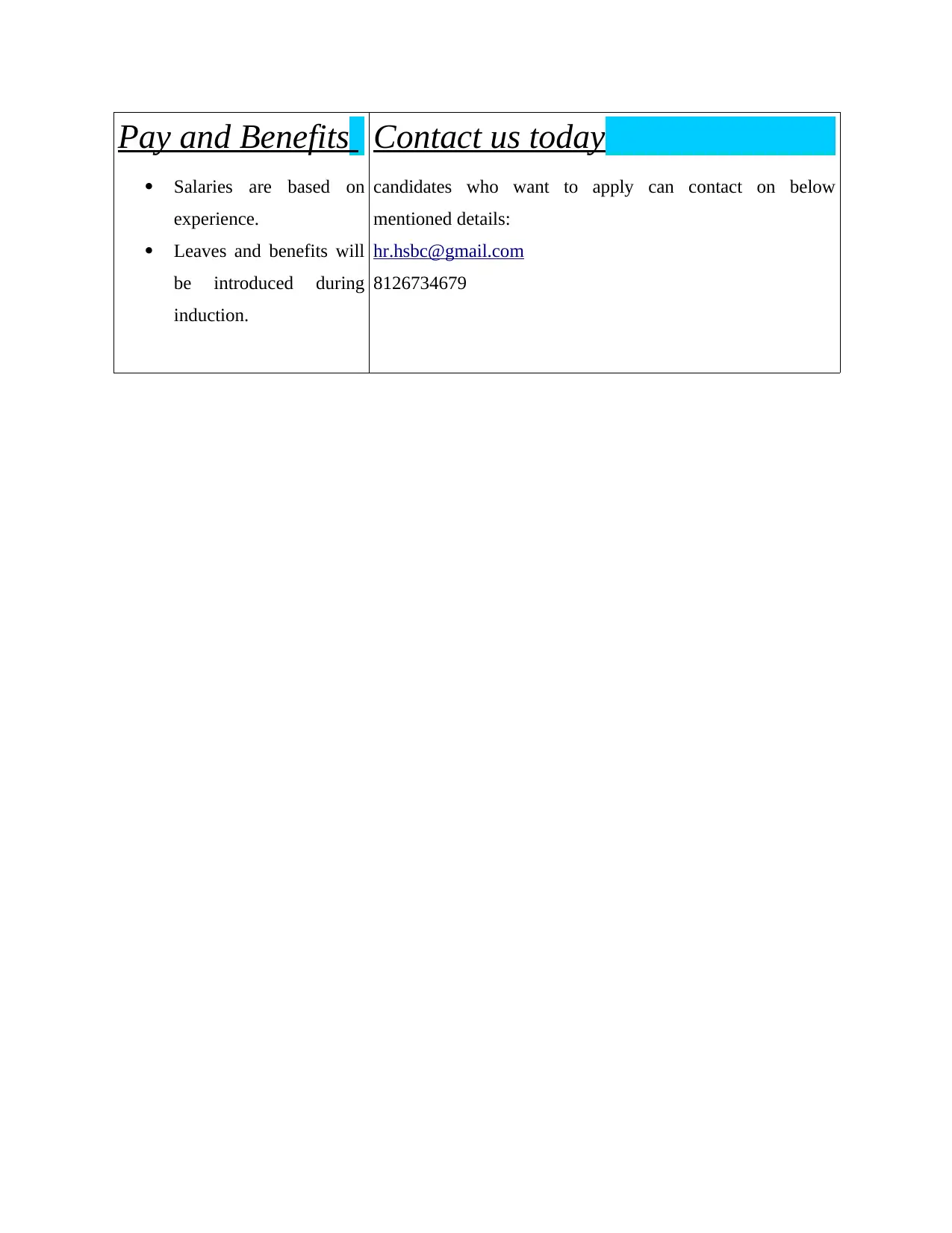
Pay and Benefits
Salaries are based on
experience.
Leaves and benefits will
be introduced during
induction.
Contact us today
candidates who want to apply can contact on below
mentioned details:
hr.hsbc@gmail.com
8126734679
Salaries are based on
experience.
Leaves and benefits will
be introduced during
induction.
Contact us today
candidates who want to apply can contact on below
mentioned details:
hr.hsbc@gmail.com
8126734679
Paraphrase This Document
Need a fresh take? Get an instant paraphrase of this document with our AI Paraphraser
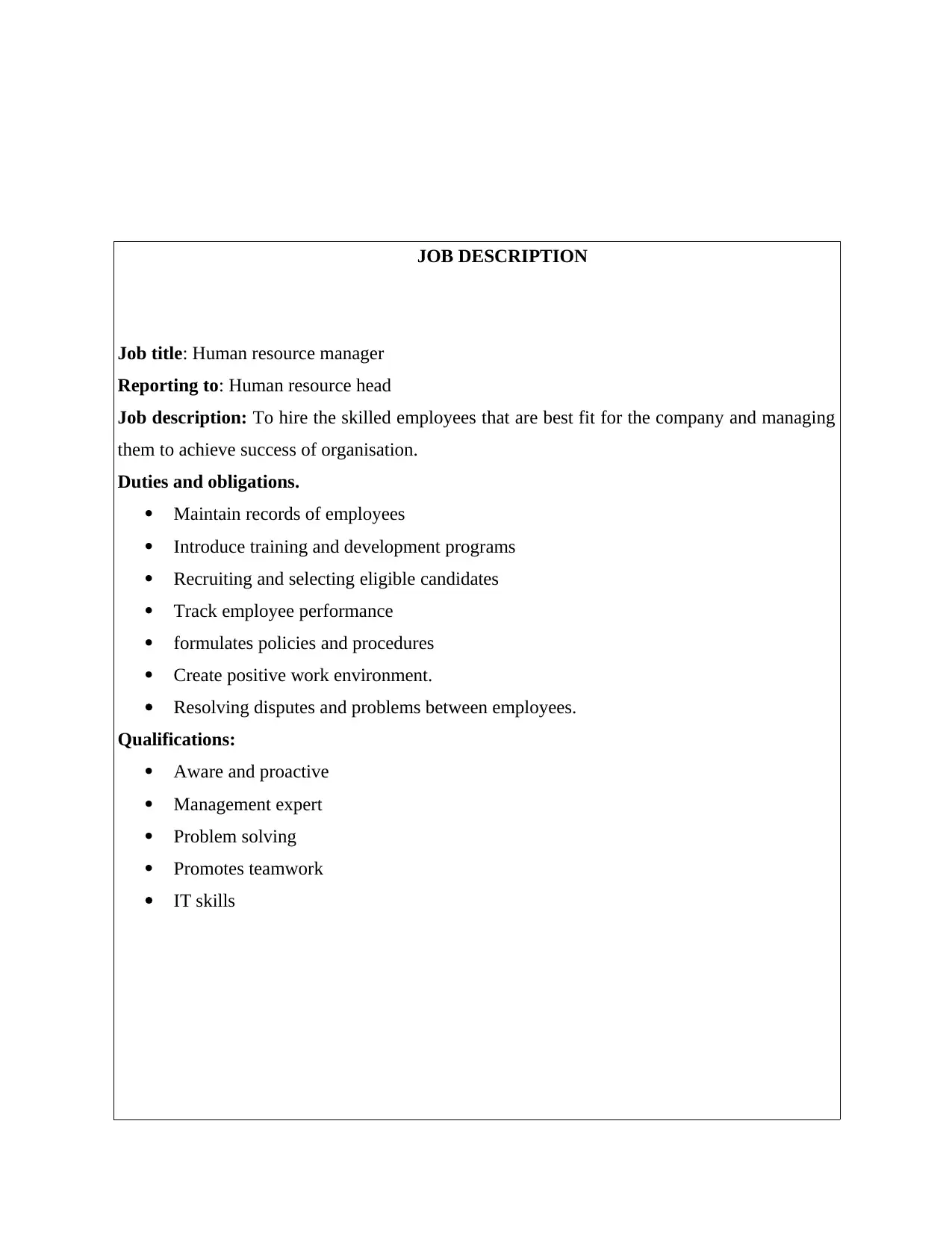
JOB DESCRIPTION
Job title: Human resource manager
Reporting to: Human resource head
Job description: To hire the skilled employees that are best fit for the company and managing
them to achieve success of organisation.
Duties and obligations.
Maintain records of employees
Introduce training and development programs
Recruiting and selecting eligible candidates
Track employee performance
formulates policies and procedures
Create positive work environment.
Resolving disputes and problems between employees.
Qualifications:
Aware and proactive
Management expert
Problem solving
Promotes teamwork
IT skills
Job title: Human resource manager
Reporting to: Human resource head
Job description: To hire the skilled employees that are best fit for the company and managing
them to achieve success of organisation.
Duties and obligations.
Maintain records of employees
Introduce training and development programs
Recruiting and selecting eligible candidates
Track employee performance
formulates policies and procedures
Create positive work environment.
Resolving disputes and problems between employees.
Qualifications:
Aware and proactive
Management expert
Problem solving
Promotes teamwork
IT skills
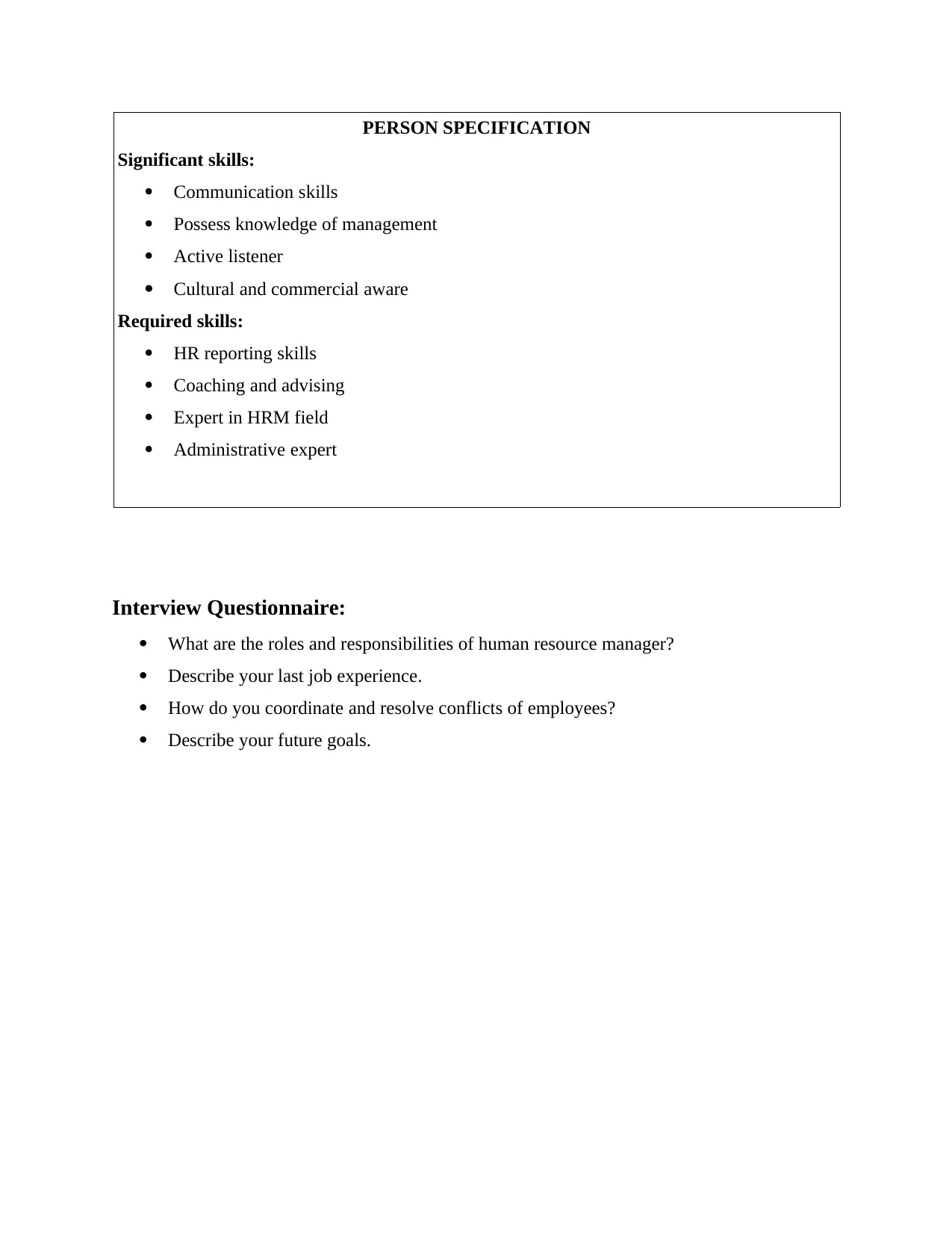
PERSON SPECIFICATION
Significant skills:
Communication skills
Possess knowledge of management
Active listener
Cultural and commercial aware
Required skills:
HR reporting skills
Coaching and advising
Expert in HRM field
Administrative expert
Interview Questionnaire:
What are the roles and responsibilities of human resource manager?
Describe your last job experience.
How do you coordinate and resolve conflicts of employees?
Describe your future goals.
Significant skills:
Communication skills
Possess knowledge of management
Active listener
Cultural and commercial aware
Required skills:
HR reporting skills
Coaching and advising
Expert in HRM field
Administrative expert
Interview Questionnaire:
What are the roles and responsibilities of human resource manager?
Describe your last job experience.
How do you coordinate and resolve conflicts of employees?
Describe your future goals.
⊘ This is a preview!⊘
Do you want full access?
Subscribe today to unlock all pages.

Trusted by 1+ million students worldwide
1 out of 16
Related Documents
Your All-in-One AI-Powered Toolkit for Academic Success.
+13062052269
info@desklib.com
Available 24*7 on WhatsApp / Email
![[object Object]](/_next/static/media/star-bottom.7253800d.svg)
Unlock your academic potential
Copyright © 2020–2025 A2Z Services. All Rights Reserved. Developed and managed by ZUCOL.





